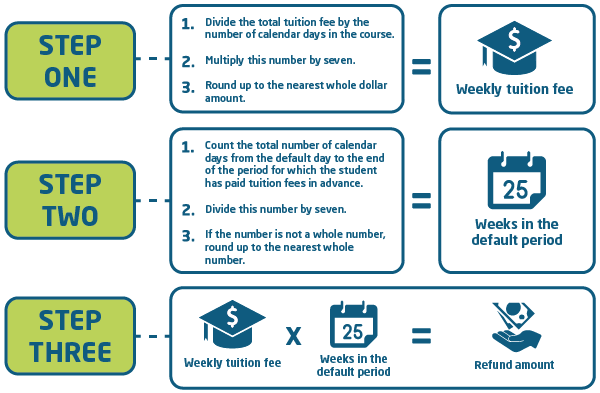- Home
- Your student obligations when a default occurs
- Refunding students
Refunding students
You must refund any unspent tuition fees to affected overseas students in the following situations:
- You have defaulted and chosen not to arrange an alternative course.
- You have defaulted and are unable to arrange an alternative course within 14 days of the default date.
- A student has not accepted the alternative course you have arranged within 14 days after the default date.
Refund amount
For any overseas student who has paid tuition fees towards a course at a location, but has not yet commenced that course, you must refund 100 per cent of the tuition fees to the student.
For any overseas student who has paid tuition fees and has commenced the course at the location, you may retain the spent portion of the student’s fees, but must refund the unspent portion.
The method for calculating the amount of refund owed to an overseas student as a result of a provider default is set out under the Education Services for Overseas Students (Calculation of Refund) Specification 2014 (the ESOS Refund Specification).
How to calculate the refund amount
There are three steps involved in calculating the amount of refund owed to a student:

Applying this calculation is a statutory requirement. You cannot apply your own deductions to the refund of tuition fees for a student.
If you have paid any part of the tuition fees to an agent involved in the recruitment of the overseas student, you may not deduct this agent fee from the tuition fees that you must refund the student.
Example—calculating the refund for a student
Lee is undertaking a 48 week Advanced Diploma of Hospitality Management at Hospitality Training 4U. The total tuition fee for the course is $8200.
Lee has prepaid $4100 in tuition fees towards his course. He commenced on 7 January 2019.
Hospitality Training 4U has defaulted in respect of Lee and his course on 6 May 2019.
Weekly tuition fee calculation:
$8200 (total tuition fees) divided by 336 (total calendar days in course)*7 = $171 (rounded up to nearest dollar amount).
Weeks in default period:
Lee has paid $4100 to date. This means he has paid in advance up until 24 June 2019.
There are 49 calendar days between 6 May 2019 (the default day) and 24 June (the date student has prepaid until.
49 days divided by 7 = 7 weeks in default period
Refund amount:
$171 (weekly tuition fee) multiplied by 7 (weeks in default period) = $1197 refund
Share
